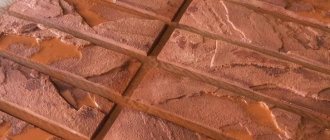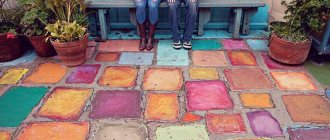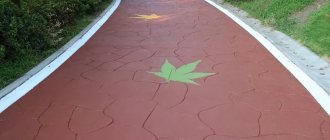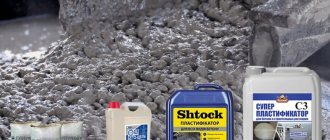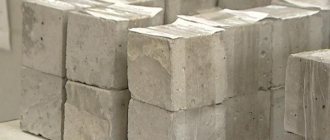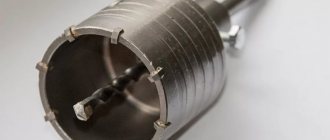The era of dull and gray concrete products is over. Modern technologies make it possible to give building materials any colors and shades.
This can be done using pigments. Colored concrete is widely used in the creation of paving slabs, paving stones, side stones, curbs, stairs, decorative sculptures, etc. The popularity of colored compounds in the construction and renovation of houses is growing every year.
Pigments for concrete can be added to the solution during mixing or applied to the surface of the structure after the composition has hardened.
Substances that give color to a structure can be of natural or synthetic origin. The color saturation depends on the chemical composition of the pigment. For example, red color is achieved using red iron oxide, white - titanium dioxide. Mineral coloring additives include chromium oxide, red lead, manganese, etc.
Mixing colored concrete
To ensure uniform distribution of color throughout the entire structure, it is best to add dye at the stage of mixing the solution. Even if after some time the top layer is erased in some places, the product will not lose its attractive appearance.
The degree of color saturation directly depends on the amount of dye that you add to the composition. However, the cost of such pigments is quite high. Therefore, the price of colored concrete is higher than traditional concrete.
It’s not difficult to make such a colored solution with your own hands, the main thing is to strictly follow the proportions:
- 1 part cement; 2.5 parts sand; 4 parts fine gravel; 1.4 parts water; dye.
You can achieve the maximum effect if you take white sand and white cement. In this case, you will be able to get a beautiful shade even with a minimum pigment content.
Before adding the coloring agent to the mixture, it should be diluted in a small amount of water. Pour the resulting mixture into the solution gradually, stirring continuously. The homogeneity of the solution directly depends on the quality of mixing.
If you want to save on dye, fill the area to 2/3 of the depth with simple cement mortar, and place a layer of colored mortar on top.
Pigments and cement selection
Inorganic iron oxide pigments will help give concrete the look of antique stone. Practice has shown that these dyes retain their characteristics for up to 25 years
The master has the right to use any cement to produce colored concrete, but some nuances should always be taken into account. The initial shade of Portland cement affects the final color of the finished material.
It should be understood that the gray tone of Portland cement muffles the tones, contributing to the contamination of the shade and reducing its saturation . When rich, bright colors are needed, it is recommended to use white cement, since when pigment is introduced into concrete, the cement stone is painted - it is enveloped in a thin layer of coloring particles.
Painting concrete base using etching method
If you decide not to overpay and want to make a concrete dye yourself, you can start by creating a perchloric acid dye. It does not allow moisture to pass through, but at the same time provides air access. Compared to other acid dyes, perchloric acid pigment is 1.5 times more durable.
To create chlorine paint you will need:
- 0.24 liters of calcium chloride; 0.5 kg of dry lime paint of the desired color; 1.1 liters of fluff lime; 7 liters of water; 25-30 g of laundry soap per 1 bucket of paint.
Stir fluffed lime in 5 liters of water. Grind the lime paint in a small volume of water and bring it to 1 liter.
Add calcium chloride to this composition. Separately, dissolve soap shavings in a small amount of warm water. Pour all this into the previously prepared composition and filter through a layer of gauze.
Clean the surface from dust and degrease it with a solvent. Painting the concrete base is carried out with a roller or brush in 1-2 layers, after which we give 6 hours for the chemical reaction to occur.
Then rinse the surface with a stream of cold water and dry it with a soft sponge. After complete drying, check the brightness of the color and, if necessary, apply another layer. When working, you should use protective equipment (rubber gloves and goggles). Water-based acid dyes react with calcium dioxide in concrete, resulting in the creation of complex, insoluble colored compounds. Using this homemade dye, you can not only give concrete the desired shade, but also protect it from moisture. Just recently, my wife and I were lucky enough to purchase own an old house in one of the nearby villages.
I will say that this house was not anything good, since it needed to be rebuilt practically from scratch. Probably the only thing that suited us about it was that there was a magnificent grape and apple orchard, and several acres of land for a vegetable garden. In order for our new house to look great, we decided that we would start with the foundation, but make it an unusual gray and multi-colored. There are a lot of articles on the Internet about how to paint concrete, and after reading a little, I decided to try making a dye for do-it-yourself concrete. I’ll get ahead of myself and say that at the same time we learned the basics of preparing concrete in a concrete mixer.
How to make a dye for concrete with your own hands
First, there are two ways to paint concrete.
This is the usual painting after drying, and coloring the concrete while working. I decided to try both ways. I decided to paint the foundation and blind area during mixing, and the path to the garden after the concrete had completely dried.
And so, when I started building a house, before pouring the foundation, I bought some things to paint. This is not a cheap way, but in the future, I won’t have to spend money on paint for constant touch-ups.
My wife and I went to the store to choose a color and dye for concrete. Upon arrival, I learned a lot about painting concrete. Firstly, concrete can be colored with several dyes, and secondly, they differ from each other.
Types of dyes
The store salesperson said that they have several types of dyes on sale.
The first of them was acidic. We're told this is one of the most popular methods of staining concrete today. The dye is an absolutely harmless powder, which, when mixed with concrete, acquires the required color
The next option we were offered was acrylic paint.
This is a fairly cheap option for painting walls, but not the worst. Acrylic paint has very good properties. It doesn't fade for a very long time and holds the color well.
There are a huge variety of color options, allowing you to choose the color you want. And the main advantage for me was that I didn’t have to figure out how much dye to add to the solution.
Simple option
We were also suggested to use simple dyes for concrete with our own hands. They, like acidic ones, have a powdery appearance. The advantage of such dyes is that they are easy to mix and have a large number of colors.
When buying such a dye, we would have to be very careful in our choice, since if we buy poor quality paint, we can constantly tint certain places in the future. Because such material quickly fades in sunlight, and is very weak to natural disasters.
Dry dyes
There are also dry dyes.
This type of concrete painting did not seem too simple to me, because it is applied to fresh concrete with a trowel, in a relatively thin layer. But on the other hand, this type of coloring has a huge number of shades. The color does not fade and is resistant to weather changes.
And one last thing. What the consultant suggested to us were color additives. As he told us, they can be in either liquid or powder form.
It must be added to wet concrete. This contributes to the complete coloring of the concrete; they can also be called concrete pigments. This ensures that concrete does not fade over time and withstands all weather conditions very well.
So, after weighing all the pros and cons, I decided that I would use acrylic paint to paint the gazebo and the foundation under it, I decided to paint the path from the house to the gazebo with an acid dye, since it would look like tiles.
And when painting the foundation of the house and the concrete blind area poured with my own hands, I decided to use colored dyes. After the construction was completed, I got what I needed.
And the video will show a complete overview of all the dyes that you can use.
Architectural and construction design, as a way to implement conceived ideas, has recently become the norm, accessible to any average person. At the same time, achieving the goal is carried out with the help of new construction technologies. One of such popular construction solutions of modern technologies is colored concrete, which, in combination with surface structuring, gives an unsurpassed result.
DIY concrete dye
This method of decoration is used today in all types of concrete products, from paving slabs to concrete sculptures. It should also be noted that this area is rapidly developing, which significantly affects the durability of dyes and its positive impact on the quality of concrete.
It should also be noted that dyes for concrete are generally produced industrially, but folk dyeing methods create their own technologies based on the chemistry of substances used in construction.
Colorants for concrete mixtures are usually added during mixing and can also be used as a painting material on the surface of the finished product.
Such dyes can be natural in nature (mineral: chromium oxide, manganese, etc.), as well as synthetic. For example, iron oxide produces a red color, while titanium dioxide produces a white color.
Advantages of painting concrete at the preparation stage
The only drawback of the method is the high cost of materials. To obtain a rich and deep color, you will need to introduce a significant amount of a substance, the price of which is not small.
If the introduction of dyes is implied at the stage of mixing the solution, a number of advantages can be obtained:
- through coloring of the entire mass of material;
- when the top layer is abraded, the beauty and richness of color are not lost;
- in the manufacture of curbs, paving slabs and other reinforced concrete products, it is recommended to use this type of painting, since the finished structure does not require updating or touching up for many years;
- colored concrete obtained by this method can be used for monolithic pouring of retaining walls, platforms, and colored concrete paths.
After the material dries, the coloring matter does not dissolve in water, oil and other solvents, and is resistant to sun fading
Using dye in concrete mix
Adding dye to the concrete mixture gives a more reliable and durable result due to the depth of penetration. Also, even if over time the top layer of concrete is rubbed and worn out, its color structure does not change.
Adding dye to concrete mixture
At the same time, experts note that the cost of such concrete increases significantly with the cost of coloring substances.
It is this method that is most often used for the manufacture of decorative paving slabs, as well as elements for arranging open areas of the home.
This method is also very effective when using concrete mixture for pouring large surfaces (platforms, driveways, paths, etc.). After all, over time, their decorative layer does not change; they do not need to be tinted or the decorative layer restored.
Color depth is achieved by using the calculated ratio of the amount of concrete mixture to the amount of dye. Changing the concentration allows you to get several shades of the same color
Penetrating painting of concrete surfaces
This method of painting concrete products is no different from the usual procedure for painting products. However, it should be noted that the structure of concrete, when hardened, retains its moisture absorption properties. And this feature is used for additional protection of the concrete surface and for its coloring.
Sample of painted concrete
Essentially, concrete painting uses deep penetrating bases that penetrate up to 5 millimeters into the concrete. In this case, the concentrated coloring of the penetrating base after application changes the color of the top layer of concrete for many years.
This method of painting is very similar to painting wooden products with impregnations, however, water-based impregnations are not entirely suitable for concrete structures due to the insignificant level of penetration and possible leaching over time.
For this reason, you should carefully select penetrating bases, which can be specially designed for this purpose; you can also use varnishes, impregnations for concrete and bases for preparing paint mixtures as a basis.
The main indicator of the base is the depth of penetration of the impregnation into the surface layer of concrete, as well as the level of its leaching and color change under the influence of the environment in the form of rain, snow, ice, wind and sun.
For this reason, experts recommend using this method of painting concrete products in places with low operational load.
Pigments for concrete / Dyes for concrete
Dyes (pigments) for concrete are used to give color to concrete and building mixtures Advantages:
|
| Retail price from 2925 RUR/pack Packaging 25 kg |
| Classification of pigments | |
| Iron oxide | Organo-mineral |
| Green 234 | Blue 1001 |
| Surik | Green 230 |
| KJO 50 | Scarlet 780 |
| Brown 652 | Yellow 590 |
| Brown 650 | |
| Orange 980 | |
| White – titanium dioxide based (TiO2 based) | |
Pigments for concrete: prices
| Photo | Color | Manufacturer | package | up to 500 kg. |
| Blue 1001 | Russia | 25 kg. | 4625. | |
| Dark Green 234 | Russia | 25 kg. | 4450 rub. | |
| Emerald Green 230 | Russia | 25 kg. | 5000 rub. | |
| Scarlet 780 | Russia | 25 kg. | 4250 rub. | |
| Lemon Yellow 590 | Russia | 25 kg. | 4250 rub. | |
| Mustard yellow 580 | Russia | 25 kg. | 3000 rub. | |
| Surik | Russia | 25 kg. | (on request) | |
| Red-brown KZhO – 50 | Russia | 25 kg. | 2925 rub. | |
| Brown 650 | Russia | 25 kg. | 2925 rub. | |
| Orange | Russia | 25 kg. | 4250 rub. | |
| White | Russia | 25 kg. | 5325 rub. | |
| Black FEPREN B-630 | Czech | 25 kg. | 7825 rub. | |
| Brown FEPREN NM-470A | Czech | 25 kg. | 5500 rub. | |
| Red FEPREN TR-200 | Czech | 25 kg. | 4200 rub. | |
| Red FEPREN TR-303 | Czech | 25 kg. | 4200 rub. | |
| Yellow FEPREN Y-710 | Czech | 15 kg. | 3750 rub. | |
| Yellow 313 | China | 25 kg. | 5125 rub. | |
| Green 5605 | China | 25 kg. | 6125 rub. | |
| Brown 686 | China | 25 kg. | 4925 rub. | |
| Red 130 | China | 25 kg. | 5125 rub. | |
| Orange 960 | China | 25 kg. | 5750 rub. | |
| Black 722 | China | 25 kg. | 4500 rub. | |
| Black 770 | China | 25 kg. | — | |
| Red 110 | China | 25 kg. | 5625 rub. |
RECOMMENDATIONS FOR COLORING CONCRETE WITH PIGMENTS
1. Raw materials for the production of painted products.
1.1. Pigments.
The choice of pigment is critical to the quality of the final product. They are subject to the following basic requirements:
- high coloring ability;
- resistance to the aggressive environment created by highly alkaline cement binders;
- light fastness;
- weather resistance.
Pigments should not dissolve in mixing water. During the manufacturing process of colored concrete, they must be distributed evenly and steadily throughout its volume. With the help of pigments used to color concrete, you can achieve almost any tone or shade that is in greatest demand. However, it should be remembered that a pure color, such as yellow, can only be achieved using white cement.
1.1.1. Colors.
The most popular colors for concrete coloring are:
- red;
- green;
- blue;
- black;
- brown;
- yellow.
1.1.2. Color intensity. Color intensity is an important indicator of the quality of pigments. Ultimately, color performance is the decisive factor in assessing the economics of a given pigment, subject to other basic requirements. Color intensity refers to the ability of a pigment to color the environment in its color. Relative coloring ability can be assessed as the ratio of the mass part of the standard pigment to the mass part of the test pigment when the same intensity is achieved.
1.1.3. Safety precautions and industrial sanitation.
Powdered pigments are non-toxic and do not irritate the skin and mucous membranes. However, when working with them, dust formation should be avoided in order to maintain sanitary and hygienic standards in the workplace. Pigments do not harm organisms living in the aquatic environment due to their insolubility, but they cause coloration of water. If pigments are released into the environment, they should be collected in dry or moistened form.
2. Factors affecting the color of concrete.
2.1. The color of cement and its effect on the color of painted concrete.
Portland cement comes in various shades of gray. Gray color mutes all other colors and shades. Therefore, when painting concrete that is produced on the basis of ordinary Portland cement, it is impossible to achieve the brightness and richness of color that can be achieved with white cement. The degree of saturation and purity of color obtained with white cement also depends on the color of the pigment itself. In the case when black pigment is used, gray cement painted with it is practically no different from concrete painted with white cement. In the case of red-brown pigment, this difference is insignificant. When it comes to green, blue and especially yellow pigments, the differences can be dramatic. The higher the purity of the desired shade, the lighter it is, the greater the need to use white cement. It should also be taken into account that in practice the color of gray cement varies from light gray to dark gray. Changing the type of cement or supplier often leads to a change in the final color of the concrete obtained after painting. The reason for this is the difference in the original color of the cement.
2.2. Fillers.
When producing colored concrete, filler particles are enveloped in a colored cement binder. In this case, it may happen that the filler particles are not completely covered, which leads to the influence of the color of the filler on the final shade of the concrete. The influence of the color of the filler on the shade of concrete is even more noticeable due to atmospheric exposure, when the grains of the filler appear more clearly on the concrete surface. In this case, a visual mixing of colors occurs. The same color of sand has a similar effect on light tones of concrete (yellow, blue, green). This impact is significantly reduced when it comes to brown or black concrete.
2.3. The influence of the amount of pigment on the quality of colored concrete.
Information about the optimal amount of pigment required to obtain the desired result helps to save money, since in this case there will be no overuse of an expensive (compared to other components) product. As the pigment part in the composition increases, a linear increase in color intensity is achieved. With a further increase in the amount of pigment, a moment comes when no change in color intensity is observed. It is from this moment that increasing the proportion of pigment in the mixture becomes economically unprofitable. The recommended upper limit for the use of pigments in concrete mixtures based on gray Portland cement is limited to 6% of the pigment by weight of the binder. Most often, 3-5% is administered. In the case of using less intense pigments, the saturation limit is reached when adding significantly more pigment. However, it may happen that the amount of pigment required to obtain the desired result will increase to such an extent that it will entail negative consequences in the form of a deterioration in the technological characteristics of concrete (this occurs when the proportion of pigment increases above 10% by weight).
2.4. Water-cement ratio and concrete color.
Excess mixing water evaporates from the concrete, leading to the formation of small pores that scatter the incident light and brighten the concrete. The higher the water-cement ratio, the lighter the concrete appears. The influence of this factor on the difference in shades can be almost completely eliminated by careful adherence to concrete preparation technology.
2.5. The color of concrete depends on the cement content.
When painting concrete, it is not the filler that is painted, but the cement binder, which, in turn, covers individual particles of the filler. The more the colored cement binder is diluted with filler, the less saturated the final color of the concrete becomes. At the same level of pigmentation, concrete with a high cement content has a significantly more intense color than concrete with a low cementitious content.
3. Features of the production of colored concrete.
3.1. Dosing and distribution of pigment in concrete.
Requirements for the quality and color fastness of painted concrete products are constantly in the spotlight of consumers. For this reason, concepts such as pigment dosing and distribution in concrete become important quality criteria. If we talk about the dispersion of pigment in a concrete mixture, it should be noted that the question of the order and time of supply of pigment to the concrete mixer is of great importance in practice.
The color appears best when the components are loaded in the following order:
- loading cement;
- pigment loading;
- mixing
- loading other components;
- mixing;
- unloading concrete.
Naturally, the mixing time is also of great importance, as is the fact whether a sufficient degree of homogeneity of the mixture has been achieved. For each type of concrete mixer, a minimum mixing time must be specified.
3.2. Effect of curing conditions on the color of concrete.
Cement stone, which appears when cement is mixed with water, is, depending on the curing temperature, more or less large crystals. The size of these crystals determines the scattering of light falling on concrete. There is a pattern: higher curing temperatures cause the formation of smaller needle-shaped crystals. The greater scattering of light by the needle-shaped crystals causes the shade of concrete cured at a higher temperature to appear lighter than the shade of the same concrete cured at a lower temperature. This fact becomes obvious when the temperature difference is significant, for example, concrete cured in a steam chamber is compared with concrete cured at room temperature.
4. Salting out limestone on concrete.
Efflorescence on concrete products is a problem for all manufacturers. It acquires particular importance in the case of high aesthetic requirements for the appearance of building materials. The practice of coloring concrete suggests that light-resistant pigments do not have any effect on the salting out process. Another thing is that white limescale stains are much more noticeable on a painted surface than on gray or white concrete. Lime stains appear on the surface of concrete due to the fact that when cement sets, free lime is formed, which, dissolving in water, falls on the surface of the concrete, reacts with carbon dioxide in the air and turns into insoluble calcium carbonate. The porosity of the concrete also plays a role. The higher the density of concrete, the less prone it is to limescale. Salting out may disappear over time as calcium carbonate reacts slowly with carbon dioxide dissolved in water and turns into bicarbonate, which is soluble in water.
Preparation of concrete mixture with dye
Ensuring uniform and deep coloring of the product is achieved by adding dye to the concrete mixture. Moreover, it should be added precisely at the stage of its preparation.
Experts also recommend distributing the coloring matter evenly over the base, which can significantly reduce the final time for preparing the colored concrete mixture. The more carefully this procedure is performed, the faster the final result.
An indicator of the readiness of the mixture is the presence of a uniform color, regardless of where the solution is taken to assess the level of coloring. Compliance with the proportions will ensure that the concrete mixture is prepared with the same level of coloring from batch to batch. At the same time, the irrational use of dyes can not only change the final color of the concrete mixture, but also significantly increase the costs of its preparation, because such dyes are quite expensive.
Also, as practice shows, the quality of a concrete mixture depends on compliance with the proportions of the constituent components of the final mixture:
- - 1 measure of cement; - 2.5 measures of sand; - 4 measures of gravel (fine); - 1.4 measures of water; - measure of dye (by volume of the mixture).
The maximum color effect when using coloring agents in a concrete mixture is achieved if white sand and/or cement is used for its preparation. This reduces the amount of dye used to obtain the desired shade. Also, to speed up the preparation time of the mixture and obtain a uniform distribution of the coloring matter, the dye should be diluted in water before adding to the concrete mixture and added to it in the state of a liquid solution.
Another little secret from practitioners for saving money to create colored concrete. You can first fill 2/3 of the volume of the product or area, and top it up with a 1/3 layer of colored concrete.
Properties and characteristics of pigments for concrete
Pigments have a number of properties. Among the most important are the following:
- Rust resistant. Adding a dye allows the cement to resist corrosion.
- Ability to cover the original color of concrete. The higher this property, the less pigment is required to paint gray.
- Dispersion: the finer the grind of dry paints, the better. This powder will dissolve faster and better in the mixture.
- Light fastness: the dye should not fade from exposure to direct sunlight. The higher the light fastness, the longer the rich color will last.
- Alkali resistance. Cement contains alkali, the paint should not disintegrate upon interaction.
- Oil absorption: on average 40-100 per 100 grams of paint. The pigment must retain oily substances. The lower the value, the higher the quality of the pigment.
When choosing a composition, you need to pay attention to these characteristics.
In what forms are they produced, how to choose
Pigments come in different forms. They can be:
- Liquid.
- Semi-liquid.
- Dry (powder).
When choosing a dye, it is important to pay attention not only to color and cost, but also to technical characteristics. Powders are most often chosen: they mix better with raw concrete and have good water-repellent properties. However, liquid dyes usually have a richer color and require less of them.
Painting the surface of concrete products
Save personal money and make beautiful colored concrete using the method of painting it yourself using a chlorine-based dye.
Paint for concrete floors
This base provides resistance to moisture penetration and also maintains the necessary porosity when exposed to air.
Also, such a base has several times longer service life.
Of course, you can use ready-made paints, but you can also make your own.
The creation of perchloric acid dye is carried out in accordance with the proportions:
- - 0.25 liters of calcium chloride; - 0.5 kg of colored dry paint (lime); - 7 liters of water; - 1.1-1.2 fluff lime; - 20-30 grams of laundry soap per 10 liters of paint.
We dilute fluffed lime in 5 liters of water. Stir dry paint in a small volume of water, gradually adding water, bringing its total volume to 1 liter.
Calcium chloride is added to the resulting mixture. In another bowl, make a soap solution in warm water. After this, mix the prepared solutions and pass them through a gauze filter so that the final composition does not have grains or lumps.
Concrete coloring process
To carry out painting work on concrete, it is necessary to first clean it of dirt and dust, and also degrease it.
Concrete is painted with a sprayer, roller or paint brush in one or two layers, allowing each layer to dry for at least 6 hours. During this time, the necessary chemical reaction of the layers takes place in the top layer of concrete.
To complete the drying process, the painted surface is washed with cold water and dried with a sponge. Complete drying of the surface displays the actual color shade, which can be made more saturated by repeating the surface painting procedure.
The essence of the painting process is the passage of chemical reactions of paint components in combination with concrete components. For this reason, you should adhere to personal safety rules and use protective equipment (gloves, overalls and goggles).
This method of painting not only solves design problems, but is also an additional way to protect concrete from moisture penetration.
Coloring, technology
For DIY work, white and colored cements and special fillers – dyes – are used.
The basic principles are as follows:
- if it is necessary to realize particularly light-colored concrete, it is necessary to lighten the white cement, into which titanium dioxide or titanium dioxide is introduced, in a ratio of 1-2% of the total mass of cement;
- the pigment used must be resistant to alkalis, atmospheric and light exposure;
- in private construction, for the manufacture of paving slabs and other types of artificial stone, mineral pigments are most often used, which are salts and oxides of various metals;
- mineral pigments are introduced into the working mixture in a ratio of 1-5% by weight of cement. The final indicator depends on the density and other properties of the material;
- colored pigments for concrete help to work with a wide range of shades, - chromium oxide - green, iron oxide - red, manganese peroxide - black, manganese oxide - violet, white pigments also include limestone and chalk, yellow - ocher, black - soot;
- by using mixed pigments, you can get a variety of colors, but to obtain high color expressiveness and increase the density of concrete, cement consumption increases several times;
- fine-grained concretes have good contact with dyes; to obtain high decorative qualities, compositions of 1:2, 1:3 are used, selecting the ratio of cement and water corresponding to the normal thickness of the working solution;
- to form modules from colored concrete, it is recommended to use plastic concrete mixtures that are least susceptible to delamination;
- for optimal consumption of cement and water, superplasticizers and plasticizers and complex additives based on them are introduced into the composition;
How to prepare colored concrete
In practice, the amount of color added to the concrete mixture is determined by the economic feasibility of the work and the desired color. The technology of increasing the percentage of dye leads to a high intensity of coloring, but this can worsen the performance characteristics of the finished product (strength, frost resistance, etc.).
The approximate pigment content in the concrete solution is indicated in the table data:
| Color intensity | Concrete pigment consumption per 100 kg of cement, kg |
| Faint, pastel colors, especially light concrete | 1.0-2.0 |
| Average | 3.0-4.0 |
| High | 5.0-6.0 |
*for brown and dark colors the lower limits are taken as working; Reds are characterized by average values; for green, blue, yellow – top.
Consumption percentage:
- slightly colored – 1-2%;
- medium colored – 2-4%;
- strongly colored – 4-6%.
Mixing the solution
For work, the following volumetric ratio is used: cement – 1 part, fine gravel – 4 parts, sand – 2.5 parts, water – ¼ l, pigment – according to the specified recommendations.
To improve the performance characteristics of concrete, water repellents and polymer impregnations are used; color uniformity is achieved using levelers
Mixer filling sequence:
- pigment and filler;
- cement;
- water.
Recommended kneading time:
- pigment and filler – 10-20 seconds;
- pigment, filler and cement – 15-20 seconds;
- the same with adding water - 1-1.5 minutes.
If you buy colors of primary colors - yellow, red, blue, by mixing them you can get many other shades. When combining dyes, you should check their chemical resistance to each other.
Precautionary measures
Before producing a large amount of material, it is recommended to do a test batch and pouring. This is due to the fact that the introduction of pigment can increase cracking, since the powder has high water absorption . The substance, taking part of the water and swelling, deprives the cement of water and disrupts the hydration reaction. It is recommended to use water-retaining additives and plasticizers.
Video - concrete painting technology
Today, colored concrete is actively used not only in residential but also in industrial construction. Dyes used in concreting perform both decorative and practical functions, namely, they improve the quality of the finished monolith.
Concrete staining has become especially popular among private developers who want to make their country houses and plots more attractive. Therefore, many craftsmen are interested in how to make concrete dye with their own hands. The answer to this and other questions regarding concrete pigments can be found in this article.
Price
There are many types of coloring mixtures available in the market. On sale you can find pigments for concrete from domestic and foreign manufacturers. Buyers can buy paint of a certain color and in the right quantity without much difficulty. But the price for such goods is different. The cost of dyes depends on several factors:
- Manufacturer.
- Type and color of color.
- Pigment weights.
You can buy inexpensive but high-quality pigments or purchase expensive but proven dyes.
Dyes: features and varieties
Concrete dyes (pigments) are compositions with a coloring carrier added to the solution to make it colored. If a high-quality dye is used in the work, then even harsh weather conditions will not be able to affect the shade of the monolith. When the concrete matures, the pigment cannot be removed.
There are three main types of pigments:
- Organic dyes (pigments of yellow, green, blue and brown); Metal dyes (aluminum powder, golden bronze); Mineral pigments, which in turn can be divided into artificial dyes (azure, chromium oxide) and natural (chalk, lime , graphite).
There is another classification in which dyes are divided by composition. Pigments are:
- Acrylic; Acid; Color additives; Dry.
Pigments for concrete are available in the form of:
- Pastes; Powders; Capsules; Emulsions.
Often, resourceful builders make their own concrete dyes. Often, homemade pigments come in paste and emulsion forms.
Painting methods
Coloring concrete mortar can be done using two methods:
- At the stage of preparing the mixture; After the concrete has hardened.
The first method is considered more appropriate, since concrete painted during manufacture has a longer service life. In addition, the paint layer does not have to be refreshed periodically.
The process of painting concrete using the second method is similar to the procedure for painting the walls of a building. However, it is worth remembering that in your work it is necessary to use pigments that can penetrate deep into the monolith (at least 2 mm). If you ignore this requirement, the quality characteristics of the dye will significantly decrease.
Coloring pigments
The principle of operation of the colors is that they color the mixing water , saturating the aluminates and silicates of cement with pigment. The proportional mass of the substance changes depending on the required color saturation. Pigment is a special additive, which is most often presented in the form of dry powder , emulsions, concentrated paste, microcapsules.
Classification
All additives are divided depending on their origin and type of receipt.
The main varieties are as follows:
- organic - artificial cinnabar, blue, yellow, burgundy, scarlet, pink, red, green, purple, green;
- mineral (inorganic), which are divided into: natural - obtained through mechanical processing of various materials. These are red lead (pigment for concrete) iron, kaolin, ocher, umber, manganese peroxide, lime, graphite, chalk;
- artificial - obtained from mineral raw materials that have undergone heat treatment - painter's glaze, lead, zinc, titanium white, chromium oxide, zinc greens and crowns, dry lithopone, burnt umber;
- metal – zinc dust, golden bronze, aluminum powder.
The range of modern chemicals is quite large, therefore, the main thing when purchasing is not to make a mistake with the choice. When selecting a material, you should take into account the properties and requirements for the characteristics of the painted product.
It should be borne in mind that when wet, the colors look more intense and brighter than after the concrete has hardened.
Specifications
The chemical composition of dyes determines its characteristics, such as heat resistance, corrosion resistance, chemical resistance, and color.
It is customary to identify the main parameters of the pigment composition:
- coloring ability - allows the mixture with white cement to obtain the required shade;
- dispersion - the indicator shows the fineness of grinding and affects all the properties of the pigment - the finer the particles, the higher the coloring ability;
- alkali resistance - determines the resistance of the tone to the effects of cement. Almost all pigments have excellent alkali resistance;
- Lightfastness - the ability of a shade to maintain its saturation under the influence of ultraviolet radiation. Natural pigments are more light-resistant; the majority of synthesized substances are prone to discoloration.
Cons and pros
The only, but very significant, disadvantage is the cost of the pigment. Considering that high-quality painting requires a significant amount of paint, the builder will not be able to avoid significant material costs.
However, craftsmen who want to save money decide to create their own dyes. “Do it yourself pigment for concrete” – forums and conferences with this name are often found on the Internet.
The ability to prepare pigment at home completely compensates for the previously mentioned disadvantage. In addition, dyes have a number of undeniable advantages. Among the main advantages of pigments for concrete are:
- Resistance to corrosion; Resistance to temperature changes; Resistance to ultraviolet radiation (the color does not fade in the sun); Ability to completely “fill in” the color of the concrete solution (the paint covers even the gray color of the mixture); Resistance to chemical treatment (the color remains saturated even after alkaline and cement processing of concrete).
The most popular pigment
Among all the above dyes, acid pigment for concrete is recognized as the most popular. The material is environmentally friendly: it does not have a harmful effect on the human body or the environment.
The dye is available in powder form and has a transparent structure. When the pigment enters the solution, it reacts with the cement, resulting in coloration.
If you start preparing acid paint, you can make a black pigment for concrete with your own hands, which is so popular in private construction.
To make this type of dye, you must purchase the required components in advance:
- Adhesive compositions; Special coloring additive; Solvent; Solutions necessary for fixing.
The technology for preparing the pigment is primitive: just mix all the ingredients thoroughly until the mass becomes homogeneous.
Price
If you need to get a high-quality pigment for concrete, buying a dye is easy. You can find pigment for concrete "Avito". The cost of imported dye, packaged in bags weighing 2.0 kg, starts from 570 rubles. Domestic analogues are cheaper. Their cost is 15% lower.
When purchasing a color in powder form, you should ensure that it does not contain lumps and is homogeneous
Pigments for concrete allow you to create artificial stone with high aesthetic characteristics. The high cost of colors is compensated by the long service life of finished products.
How to practically use coloring pigments for concrete is shown in the video:

